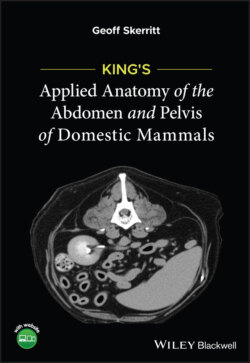Читать книгу King's Applied Anatomy of the Abdomen and Pelvis of Domestic Mammals - Geoff Skerritt - Страница 37
2.2.1 Transport of food
ОглавлениеFood transport, i.e. the active passage through the digestive tract, is promoted by the musculature that is located throughout the entire length of the digestive tract. There are two muscular coats comprising an inner circular and an outer longitudinal layer, together with a variable layer of oblique fibres. Contractions of the muscle layers promote the propulsion of food through the gastrointestinal tract, and segmental contractions ensure mixing of the intestinal contents.
In the oesophagus these layers are made up either wholly of striated skeletal muscle or partly of striated skeletal muscle and partly of smooth muscle. In the remainder of the tract the muscle layers comprise only smooth muscle innervated by the autonomic nervous system, which may either stimulate or inhibit muscular contraction. The muscle fibres can also operate independently of the nervous system; intermittent excitation is an intrinsic property of smooth muscle cells themselves, electrical transmission from muscle cell to muscle cell taking place at sites of low electrical resistance where one cell is in close apposition to another as at gap junctions. These are intimate connections between the cytoplasm of cells that allow the interchange of molecules, ions and electrical impulses.
Entry of food through the cardia into the stomach can occur following receptive relaxation of the smooth muscle of the gastric wall. The arrival of food boluses, round masses of food mixed with saliva, results in a vagal reflex that induces inhibition of muscle tone.
Transport is brought about by progressive waves of muscular contraction known as peristalsis. This results in a travelling constriction of the circular muscles arising at a point just cranial to the side of the food mass or bolus that has the effect of pushing the food caudally along the tract. Peristalsis occurs in the oesophagus, stomach and small intestines. Peristalsis also occurs in the large intestines, though the time interval between contractions is longer. An additional factor in the transport of food is the production of mucus by cells of the lining epithelium, thereby lubricating the passage of food along the intestines.
